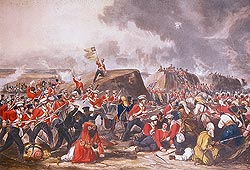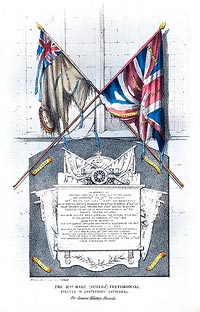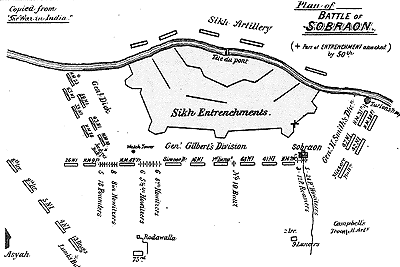The Battle of Sobraon
The Sikhs had extended their fortifications at Sobraon to second and third lines as more of their troops assembled there. By the time the final and decisive battle of Sobraon began on 10th February 1846 there were more than 20,000 of them there. They had fortified a bend in the river overlooked by high ground on the north side. The fortifications mainly consisted of strongly constructed breastworks loop-holed for musketry and deep ditches. The British needed to wait for the return of Sir Harry Smith and his 1st Division. The Commander-in-Chief then had three divisions at his disposal, a total force of about 15,000 men.
Reports indicated that the defences on the Sikh right were not continuous and did not extend to the river bank. The Commander-in-Chief therefore decided to concentrate his attack on that flank using the 3rd Division reinforced by an additional brigade. The 2nd Division in the centre and the 1st Division on the right were to mount diversionary attacks. An independent brigade was sent to distract the Sikh commanders by threatening to cross the river higher up. The army moved quietly to forming up positions during the night and waited in silence for daylight which was delayed by dense fog. An artillery duel then began which lasted for two hours by which time the British were running out of ammunition and the infantry were ordered to advance.
The 3rd Division managed to penetrate the outer line of the Sikh defences but was forced to halt and consolidate. The 1st and 2nd Divisions then converted their demonstration into serious attacks. The 2nd Division found the earthworks at the centre too high to tackle without scaling ladders but remarkably the cavalry discovered a place where it was possible to get through in file at a walk and infiltrated six squadrons. They, with successive charges, forced the mass of Sikh infantry back to the bridge, killing great numbers of them. Meanwhile the 1st Division, with the 31st Regiment on its right, had managed to penetrate the Sikh positions and slowly forced the enemy back until the whole position was taken.
 |
| Sergeant McCabe at the Battle of Sobraon. (Click to enlarge) |
The 31st Regiment had begun the battle with a bayonet strength reduced to 450 and sustained yet more casualties.
A reinforcement draft from Ambala joined from escorting the ammunition train which arrived belatedly the next day. The Regiment’s officers, eleven in all, were either lieutenants or ensigns.
At a critical moment during the battle the two officers carrying the colours, Lieutenant Tritton and Ensign Jones, were cut down. The royal colour was immediately raised again by Lieutenant Noel. Sergeant Bernard McCabe grasped the regimental colour. He gallantly rushed forward and planted it on the ramparts of the Sikh position. The following day, while the troops rested, Captain Longworth settled down to write his report on his regiment’s action.
It is currently reproduced in the regimental history of the East Surrey Regiment, and on Sobraon Day the regimental colour is ceremoniously transferred from the Officers’ Mess to the custody of the Sergeants’ Mess for the day.
Plan of The Battle of Sobraon
(Click to enlarge)
By nightfall on 12th February the bridge over the Sutlej was ready for use. Sir Harry Smith’s next day in high spirits at the prospect of invading the Punjab. A halt of some days was made while the army closed up. The advance on Lahore then began, in battle formation straight across country, each regiment keeping its own place in line. On 20th February the army camped about two miles from the city across an open plain. On 22nd February the British standard was hoisted on the citadel of Lahore.


